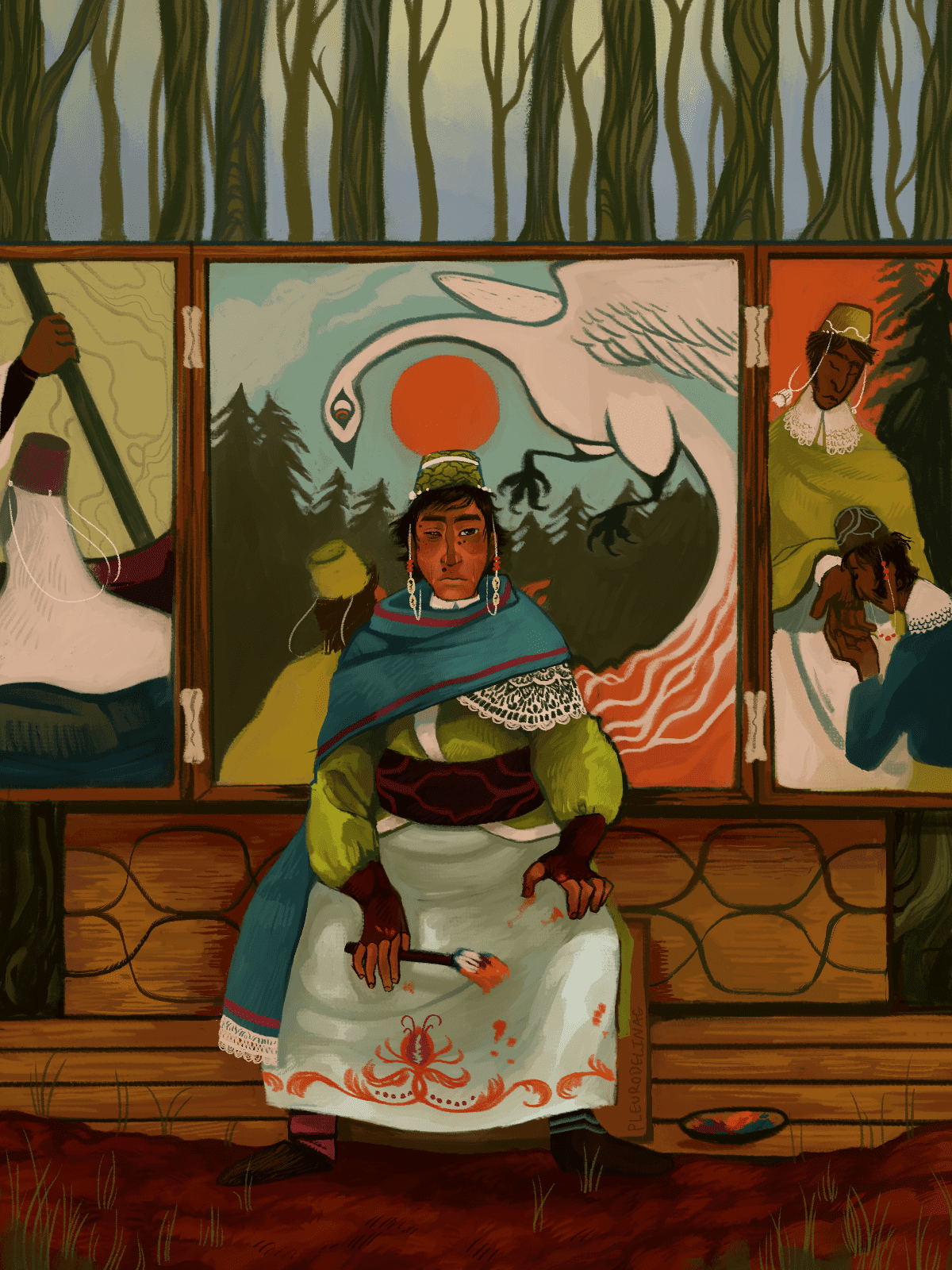
Image Description: A full body portrait of a person named Khattame. They are a brown person sitting on a crate, hands in their lap, looking at the viewer neutrally. They have a square-jawed face with wrinkles at the edge of their mouth and a large nose. One eye is shut closed and the other is sighted; they have several moles, two under their left eye, one above their lip, and the last at the corner of an eyebrow. Their straight black hair hides under a cylindrical green hat, embroidered with curvilinear shapes. Two pale strings go down from the brim of the hat and loop around from the cheeks to behind the ears; Khattame's have two conch shells and 3 wide orange beads each. A high white collar covers their neck, but is in turn covered by a very wide blue scarf that wraps around the whole of their shoulders and falls down to their knee, where the end is adorned with white lace. Lace also peels out from under the scarf and down over their breast and elbow. They are wearing a dark lime green tunic with white trim that is tucked into a wide burgundy sash, and on their arms into burgundy fingerless gloves. They have a very light, almost white, blue skirt with orange flowers around its edges. One of their feet is wood, the other is tucked into a brown leather shoe. In one hand, they hold a used paintbrush.
Next to the box they sit on is a pan filled with various pigments, and where the wood planks of the boardwalk ends, deep brown soil with low plant fronds poking up begins. In the very back, tall and thin trees rising into a murky sky can be seen. The main feature of the background, however, is the tryptich that Khattame is, presumably, painting. It sits on a wood platform adorned with curvilinear patterns. The far left panel, half cut off, still shows someone rowing a small boat as they are greeted with a mask and hat-wearing creature rising out of the water. The middle panel shows a Yakha'ai person, their back to the viewer, reaching out in reverence to a one-eyed, long-necked, white bird that soars up against the sun, its tail turning into fire. The far right panel, also cut off, shows one person kneeling to another and kissing their palm, showing clear reverence. The person standing, however, is also respectfully closing their eyes. End ID.
Khattame
for Menoyukh'al, Ventôse CCXXX, digital.
So, fellow artist, here is how the story goes: the child reads the omens from the world. They are warned by the water and the earth -- one day, after a day of fishing with their birds for little gain, a ralikhung rises from the muddy deep with trembling, disjointed words. Though they, for reasons beyond my knowing, seem to bear the shawls and hats of us Yakha'ai, their good throats are ill fit for Yabna'ai. The child, understanding nothing, dismisses it.
And so, the child is warned by the fire and the air -- walking along a path home after a day of pondering the ralikhung's message and subsequently dismissing it, they are greeted by a ukhatta, who rises from the lantern they carry and cries out in shrieks. The ukhatta's throat is also ill fit for Yabna'ai, and the child still does not understand. They, struck odd by the twice this has happened, begins to lash out. Their struck reverence is replaced by terror, and they chase the ukhatta with hands at the ready to seize its throat. But, as ukhatta do, the ukhatta vanishes, that fleeting and holy thing gone in a burst of flame. The child, realizing their mistake, weeps.
They cannot understand, but they can think. And they can speak. So they tell others -- the fisher tells the weaver, and the weaver tells the bartender, and the bartender tells the mail-runner, and the mail-runner tells the executioner. And now they all know -- and in all knowing, and all thinking, then the child can begin to understand.
The portrait of an artist from the Yakha'ai wetlands.